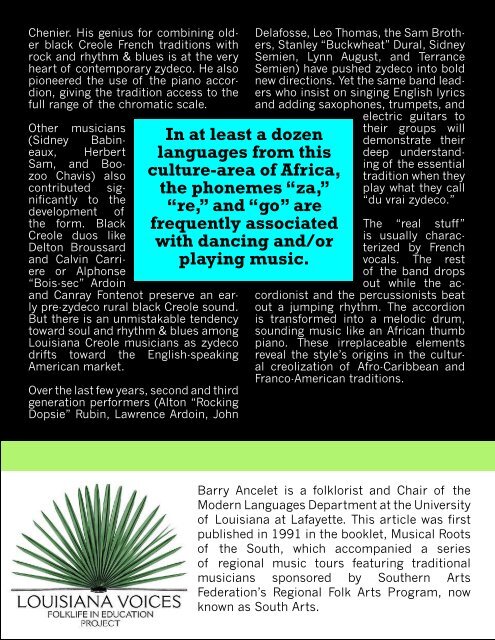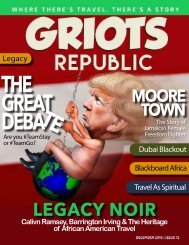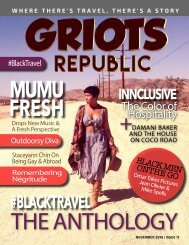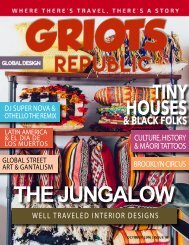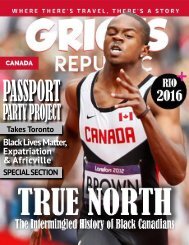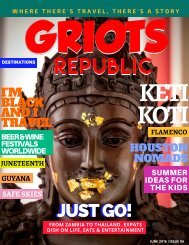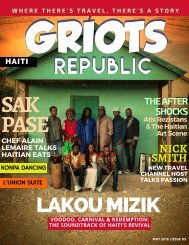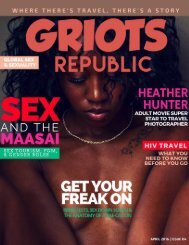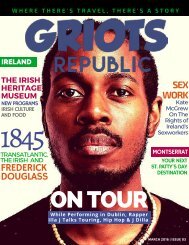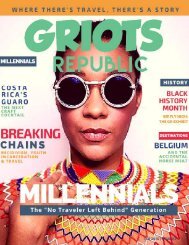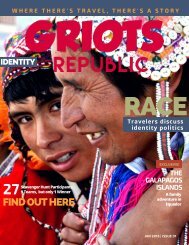GRIOTS REPUBLIC - AN URBAN BLACK TRAVEL MAG - JULY 2016
ISSUE #7: GLOBAL MUSIC In this issue we've covered global black music all around the world. Black Travel Profiles Include: Jazz Vocalist, Andromeda Turre; Conductor from Orchestra Noir, Jason Rodgers; Reggae Legend, Tony Rebel; & Miami Band, Batuke Samba Funk! For more black travel profiles and stories, visit us at www.GRIOTSREPUBLIC.com.
ISSUE #7: GLOBAL MUSIC
In this issue we've covered global black music all around the world. Black Travel Profiles Include: Jazz Vocalist, Andromeda Turre; Conductor from Orchestra Noir, Jason Rodgers; Reggae Legend, Tony Rebel; & Miami Band, Batuke Samba Funk!
For more black travel profiles and stories, visit us at www.GRIOTSREPUBLIC.com.
Create successful ePaper yourself
Turn your PDF publications into a flip-book with our unique Google optimized e-Paper software.
Chenier. His genius for combining older<br />
black Creole French traditions with<br />
rock and rhythm & blues is at the very<br />
heart of contemporary zydeco. He also<br />
pioneered the use of the piano accordion,<br />
giving the tradition access to the<br />
full range of the chromatic scale.<br />
Other musicians<br />
(Sidney Babineaux,<br />
Herbert<br />
Sam, and Boozoo<br />
Chavis) also<br />
contributed significantly<br />
to the<br />
development of<br />
the form. Black<br />
Creole duos like<br />
Delton Broussard<br />
and Calvin Carriere<br />
or Alphonse<br />
“Bois-sec” Ardoin<br />
and Canray Fontenot preserve an early<br />
pre-zydeco rural black Creole sound.<br />
But there is an unmistakable tendency<br />
toward soul and rhythm & blues among<br />
Louisiana Creole musicians as zydeco<br />
drifts toward the English-speaking<br />
American market.<br />
Over the last few years, second and third<br />
generation performers (Alton “Rocking<br />
Dopsie” Rubin, Lawrence Ardoin, John<br />
In at least a dozen<br />
languages from this<br />
culture-area of Africa,<br />
the phonemes “za,”<br />
“re,” and “go” are<br />
frequently associated<br />
with dancing and/or<br />
playing music.<br />
Delafosse, Leo Thomas, the Sam Brothers,<br />
Stanley “Buckwheat” Dural, Sidney<br />
Semien, Lynn August, and Terrance<br />
Semien) have pushed zydeco into bold<br />
new directions. Yet the same band leaders<br />
who insist on singing English lyrics<br />
and adding saxophones, trumpets, and<br />
electric guitars to<br />
their groups will<br />
demonstrate their<br />
deep understanding<br />
of the essential<br />
tradition when they<br />
play what they call<br />
“du vrai zydeco.”<br />
The “real stuff”<br />
is usually characterized<br />
by French<br />
vocals. The rest<br />
of the band drops<br />
out while the accordionist<br />
and the percussionists beat<br />
out a jumping rhythm. The accordion<br />
is transformed into a melodic drum,<br />
sounding music like an African thumb<br />
piano. These irreplaceable elements<br />
reveal the style’s origins in the cultural<br />
creolization of Afro-Caribbean and<br />
Franco-American traditions.<br />
B . B I R D W A T C H E R<br />
Barry Ancelet is a folklorist and Chair of the<br />
Modern Languages Department at the University<br />
of Louisiana at Lafayette. This article was first<br />
published in 1991 in the booklet, Musical Roots<br />
of the South, which accompanied a series<br />
of regional music tours featuring traditional<br />
musicians sponsored by Southern Arts<br />
Federation’s Regional Folk Arts Program, now<br />
known as South Arts.


